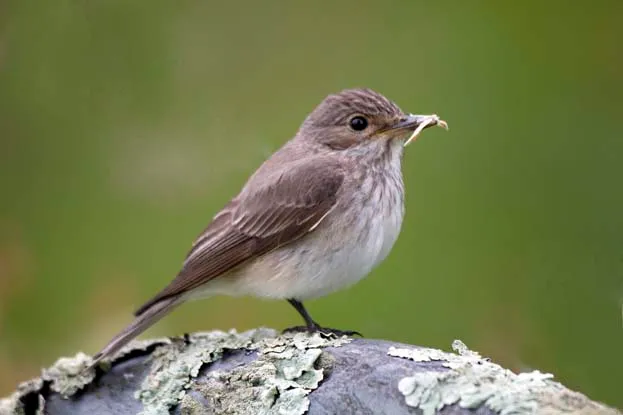1 Welcome back
Spotted flycatchers are one of our summer migrants that spend the winter in Africa. They are one of the latest migrants to reach us, with a few trickling into the country from late April and most arriving from mid-May.
2 Nesting help
Despite arriving relatively late, spotted flycatchers manage to rear two broods of young before departing at the end of August. The success of the second clutch is increased by fewer eggs being laid, meaning less mouths to fill. They will nest in gardens but the nest is usually well hidden on ledges or behind climbing plants.
3 Invertebrate dilemma
Spotted flycatchers prefer large flying insects, including flies and butterflies. However, if the weather is cool and insects aren’t flying, they will take smaller invertebrates from leaves and branches. If poor weather persists, many nests fail as these smaller invertebrates tend to be eaten by the parents rather than fed to the young.

Spotted flycatchers feed mainly on flying insects. © John Harding/BTO
4 Avoiding a sting
In order to reduce the chances of their invertebrate prey escaping, spotted flycatchers have a series of modified feathers, like bristles, down the sides of the bill. They have also adapted to catch stinging insects. They rub the sting end on their perch to remove it, making the prey safe to eat.
5 Bird in decline
The spotted flycatcher is red listed due to its rapid and consistent population decline with an 89 per cent decrease between 1967 and 2012. Evidence suggests that this is due to poor annual survival rates of first year birds, but conditions in their wintering grounds in Africa may also have contributed to the decline.
6 Unexceptional looks
Spotted flycatchers are fairly drab birds, with brown-grey upperparts. Below they have dull white plumage with pale streaking, and there is streaking on the head. Juveniles are similar but have pale spots on their upperparts. Despite their dull appearance, they are easy to spot as they like to perch on exposed posts or branches from which they catch their prey.
7 Squeaky song
As well as looking plain, the spotted flycatcher’s song is pretty unremarkable. It is squeaky, mostly unmelodic and very soft. The squeaky part of the song is part of its territorial defence, and the more musical sequences are aimed at potential mates.
The British Trust of Ornithology (BTO) works in partnership with over 40,000 volunteer birdwatchers to chart the fortunes of UK birds.
Among the surveys that we coordinate is our popular Garden BirdWatch, the largest year-round survey of garden birds in the world.
